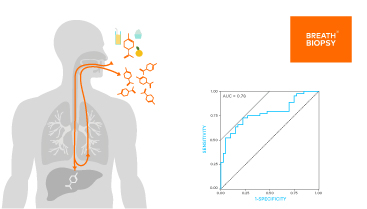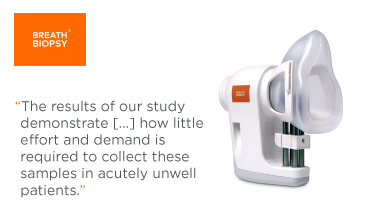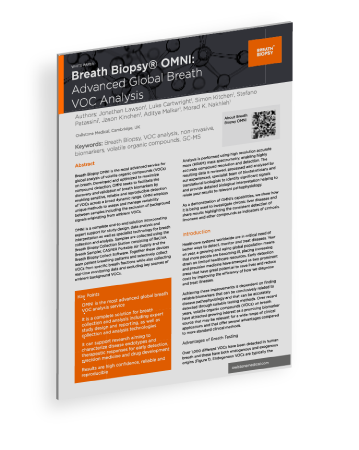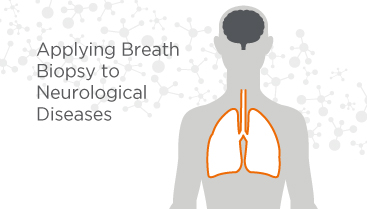Top Breath Research Papers Published in 2020
Published on: 10 May 2021
In 2020, breath research continued to progress and develop as a research field, gaining a wave of renewed interest as a result of the COVID-19 pandemic. Now that all the papers from the year have been published, we’ve picked out some of the most interesting and impactful papers from breath research in 2020.
Diagnosing COVID-19 via breath with GC-IMS
The COVID-19 pandemic brought an unprecedented level of international attention to the field of breathomics. There was an urgent need to produce tests capable of rapidly distinguishing COVID-19 from other respiratory conditions, without laboratory support. Ruszkiewicz et al.1 investigated whether breath-analysis could be used for this purpose.
Adult patients with possible COVID-19 were recruited at hospital presentation by teams in the UK and Germany, providing a breath sample for analysis by GC-IMS. COVID-19 infection was subsequently identified by transcription polymerase chain reaction (RT- qPCR) of oral/nasal swabs paired with clinical-review. All breath samples were analyzed, and potential breath biomarkers of COVID-19 were identified.
Slightly less than a third of study participants were diagnosed with COVID-19. Multivariate analysis identified aldehydes (ethanal, octanal), ketones (acetone, butanone), and methanol that discriminated COVID-19 from other respiratory conditions. Comparing levels of these ‘biomakers’ with the wider cohort allowed COVID-19 patients to be distinguished from non-COVID-19 patients with around 80% accuracy, providing significant hope that developing this approach further might allow the production of a test for use in future endemic flu seasons.
One of the co-authors of this paper, Paul Thomas, spoke about this work at BBCon 2020.
Breath-based non-invasive diagnosis of Alzheimer’s disease
Early detection of Alzheimer’s disease (AD) allows action to be taken that can help to manage or slow progression of the disease. The study by Tiele et al.2 set out to determine whether breath-based VOCs could be used to firstly successfully separate controls from AD patients and secondly stratify mild and severe AD patients. They recruited 100 age and sex matched subjects, 50 controls and 25 each of mild and severe AD patients and analyzed samples with gas chromatography ion mobility spectrometry (GC-IMS).
Six VOCs were highlighted as candidate breath biomarkers for AD detection and progression, with hexanal produced via lipid peroxidation of particular interest. The resulting models distinguished controls from severe AD patients with 0.83 AUC, controls from mild AD patients with 0.77 AUC and mild from severe patients with 0.70 AUC.
Go to paper Read our neuroscience blog
Reviewing volatomics in inflammatory bowel disease and irritable bowel syndrome
VOCs are a growing avenue of interest in gastrointestinal research that provide a readout of metabolism, inflammation and gut microbiotic processes. VOCs hold promise as non-invasive biomarkers for a range of conditions including irritable bowel syndrome (IBS) and inflammatory bowel disease (IBD). In their review paper Van Malderen et al.3 examined the existing studies that have sought to investigate the clinical applicability of using VOCs to distinguish IBS and IBD from controls, as well as to differentiate disease subtypes including ulcerative colitis and Crohn’s disease.
Collating and contrasting results from multiple studies they found the most commonly suggested potential biomarkers to be propan-1-ol for IBD patients, and 1-methyl-4-propan-2-ylcyclohexa-1,4-diene for IBS. Biologically both of these candidate biomarkers appear to associate with inflammation. Interestingly across multiple studies breath sampling was shown to be more effective than fecal sampling – exciting news for the future of personalized medicine.
Read the paper Read our gastrointestinal blog
VOCs point a way towards non-invasive liver disease detection and monitoring
In 2020 two groups published exciting papers using VOCs on breath to measure liver function and stratify liver disease.
Sinha et al.4 collected breath samples from healthy controls and NAFLD patients with and without cirrhosis. They used GC-MS to target 19 VOCs previously associated with cirrhosis, finding that levels of alfa-terpinene, dimethyl sulfide, and D-limonene can be used to differentiate between study groups. Each could be used to stratify patients with non-alcoholic fatty liver disease (NAFLD). Isoprene was also useful for distinguishing between NAFLD patients with and without cirrhosis. Combining levels of D-limonene and dimethyl sulfide together discriminated between healthy controls and cirrhosis patients with an AUC of 0.98 and between cirrhotic and non-cirrhotic NAFLD with an AUC of 0.91.

, which is why it was also a focus for Ferrandino at al.’s study6. They collected breath with the ReCIVA® Breath Sampler and used TD-GC-MS to compare healthy volunteers to both patients with cirrhosis and patients with cirrhotic hepatocellular-carcinoma. Their results confirmed that increased limonene correlates with disease severity as measured by Child-Pugh classification.
When Ferrandino at al. compared their results to existing blood biomarkers, they found that limonene correlated with three liver function markers (bilirubin, albumin and international normalized ratio (INR)). Significantly however, there was no correlation with alanine amino transferase (ALT) a measure of liver damage. Analysis of limonene and other potential biomarkers on breath therefore could allow the early detection of liver diseases, where liver function has been affected but liver damage has not yet occurred – and may still be preventable.
Read the paper Read our Limonene blog
Volatile products of lipid peroxidation
While studies identifying VOCs as possible biomarkers for disease diagnosis and precision medicine has been a growing area of research for some time, few tests have yet made it into the clinic. Validating putative biomarkers requires more than just further testing – there is also a need for hard evidence of biological relevance. One key source of VOCs within the metabolome is thought to be lipid peroxidation, a common factor in oxidative stress.
Ratcliffe et al.7 examined the process of lipid peroxidation in order to try and list the many possible volatile products. They used a mechanistic analysis of the compounds derived from molecular cleavage, comparing the result against a recent review of all the VOCs emanating from the human body. This process was able to satisfactorily explain the presence of at least 100 VOCs. They also suggest many potentially volatile products that have not previously been reported – and offer several possible explanations for this.
Go to paper Read our lipid peroxidation blog
Volatile profiles in respiration linked to inflammation
For breath analysis to get into clinic as a non-invasive diagnostic method for respiratory inflammatory diseases like asthma, the inflammatory metabolic pathways involved in VOC production need to be better characterized and understood. In their study Zanella et al.8 simulated lung inflammation in vitro using human A549 epithelial cells.
They compared VOC production after chemically induced oxidative stress in vitro by exposing the cells to H2O2, and also biological stress from exposing the cells to a pool of sputum supernatants containing inflammatory factors. Each sample was analyzed using two-dimensional gas chromatography hyphenated to time-of-flight mass spectrometry (GC×GC-TOFMS). They found that significantly different VOCs were produced by the A549 cells compared to controls, which included healthy sputum co-cultures. These changes were in direct correspondence to the type of inflammation induced. Both chemical and biological inflammation prompted an increase of carbonyl compounds (54%) and hydrocarbons (31%). Interestingly, however, only the biological inflammation model demonstrated increased VOC production linked to asthma airway inflammation.
Breath Biopsy® sampling acceptable for patients experiencing acute breathlessness

Following sample collection, Holden et al. used an assessment tool known as NASA-TLX, which uses 6 metrics to assess perceived workload and effort, to evaluate patient comfort. They found that it was both “possible and acceptable to collect breath samples from both adults and children at the bedside for breathomics analysis using the ReCIVA device”. The NASA-TLX measurements for perceived task load emphasized “how little effort and demand [was] required to collect these samples in acutely unwell patients”. In their concluding notes Holden et al. also compared ReCIVA favorably with other collection methods.
Read the paper Read our blog About this study
Engineering synthetic breath biomarkers for respiratory disease
Many potential biomarkers identified through untargeted discovery fail to progress to clinical use due to lack of validation and poor evidence to support their biological relevance. An increasing number of studies have begun to draw on established biological knowledge to select exogenous VOC compounds that interact with the body’s metabolism via known pathways. This is what Chan et al.10 have done in their study which seeks to actively engineer potential breath biomarkers for respiratory diseases.
Delivering a protease-sensing nanoparticle direct to the lungs, Chan et al. to found that the nanosensors shed volatile reporters upon cleavage by neutrophil elastase. This inflammation-associated protease has elevated activity in lung diseases such as bacterial infection and alpha-1 antitrypsin deficiency. Volatile reporters from this process are expelled in breath and detectable by mass spectrometry. Trialing these engineered candidate biomarkers in mice and analyzing breath samples with high sensitivity, they were able to identify diseased mice within as little as 10 min.
Importance of quality checks in getting good results
During any breath study non-biological variations can be unintentionally introduced, causing batch effects. These variations can occur during sampling, measuring and processing your data. Some of them can be dealt with through algorithmic approaches that focus within-study but ways to correct for cross-study batch effects are currently lacking – this makes comparisons to other studies to verify VOC profiles challenging. In their study Stavropoulos et al.11 have considered whether existing within-study correction approaches could also be used to correct for cross-study batch effects.
Stavropoulos et al. took data from three separate breath studies (inflammatory bowel disease (IBD), chronic liver disease and irritable bowel syndrome (IBS)) and applied three batch-effect-correction algorithms. In each of the three studies breath samples had been analyzed via GC-MS. The data from the three studies, before any batch-effect-correction techniques were applied, showed a clear distinction, likely due to batch effects among the datasets. After implementing all three correction techniques, the visualization of the data showed that batch effects were still present. This was confirmed using partial least squares discriminant analysis and random forest. Within-study batch-effect-correction approaches therefore fail to correct for cross-study batch effects in the data.
One way to systematically standardize future breath research data might be to use internal standards or apply quality control techniques to samples at regular analysis intervals.
Go to paper challenges in breath research
Targeted analysis of VOCs for respiratory diseases
Koureas et al.12 investigated the usefulness of breath analysis to distinguish lung cancer (LC) patients from patients with other respiratory diseases and healthy controls. For their study they took breath samples from 51 LC patients, 38 help-seekers not diagnosed with LC and 53 controls.
Using a combination of solid phase microextraction and GC-MS, 19 VOCs were quantified in breath samples, several of which were found to differ significantly between LC patients and controls. A model based on these VOCs distinguished LC patients from controls with an AUC of 0.94. However, the study was not able to achieve adequate discrimination between LC patients from patients diagnosed with other respiratory diseases.
The VOCs which most successfully differentiated LC patients from healthy controls were mainly exogenous monoaromatic compounds and 1- and 2- propanol. It’s possible that the on-breath concentrations of these compounds reflect changes to a patient’s physiological and biochemical status. Further studies should consider whether they can be used as diagnostic probes.
If you’re working in breath research, or just interested in finding out more, you’re invited to join as at the next Breath Biopsy Conference – our annual flagship event that brings together leading researchers to share the latest advances and to discuss common challenges.
References
- Ruszkiewicz et al. (2020) Diagnosis of COVID-19 by analysis of breath with gas chromatography-ion mobility spectrometry – a feasibility study EClinicalMedicine 29–30, 100609. DOI: 10.1016/j.eclinm.2020.100609
- Tiele et al. (2020) Breath-based non-invasive diagnosis of Alzheimer’s disease: a pilot study J Breath Res. 14, 026003. DOI: 10.1088/1752-7163/ab6016
- Van Malderen et al. (2020) Volatomics in inflammatory bowel disease and irritable bowel syndrome EBioMedicine 54, 102725. DOI: 10.1016/j.ebiom.2020.102725
- Sinha et al. (2020) Volatomic analysis identifies compounds that can stratify non-alcoholic fatty liver disease JHEP Reports 2, 100137. DOI: 10.1016/j.jhepr.2020.100137
- Fernandez de Rio et al. (2015) Volatile Biomarkers in Breath Associated With Liver Cirrhosis — Comparisons of Pre- and Post-liver Transplant Breath Samples EBioMedicine 2, 1243-1250. DOI: 10.1016/j.ebiom.2015.07.027
- Ferrandino et al. (2020) Breath Biopsy Assessment of Liver Disease Using an Exogenous Volatile Organic Compound—Toward Improved Detection of Liver Impairment Clinical and Translational Gastroenterology 11:e00239. DOI: 10.14309/ctg.0000000000000239
- Ratcliffe et al. (2020) A mechanistic study and review of volatile products from peroxidation of unsaturated fatty acids: an aid to understanding the origins of volatile organic compounds from the human body Journal of Breath Research 14, 034001. DOI: 10.1088/1752-7163/ab7f9d
- Zanella et al. (2020) Comparison of the effect of chemically and biologically induced inflammation on the volatile metabolite production of lung epithelial cells by GC×GC-TOFMS Analyst 145, 5148-5157. DOI: 10.1039/D0AN00720J
- Holden et al. (2020) Use of the ReCIVA device in breath sampling of patients with acute breathlessness: a feasibility study, ERJ Open Res. DOI: 10.1183/23120541.00119-2020
- Chan et al. (2020) Engineering synthetic breath biomarkers for respiratory disease Nature Nanotechnology 15, 792–800. DOI: 10.1038/s41565-020-0723-4
- Stavropoulos et al. (2020) Implementation of quality controls is essential to prevent batch effects in breathomics data and allow for cross-study comparisons Journal of Breath Research 14, 026012. DOI: 10.1088/1752-7163/ab7b8d
- Koureas et al. (2020) Target Analysis of Volatile Organic Compounds in Exhaled Breath for Lung Cancer Discrimination from Other Pulmonary Diseases and Healthy Persons Metabolites 10, 317. DOI: 10.3390/metabo10080317

